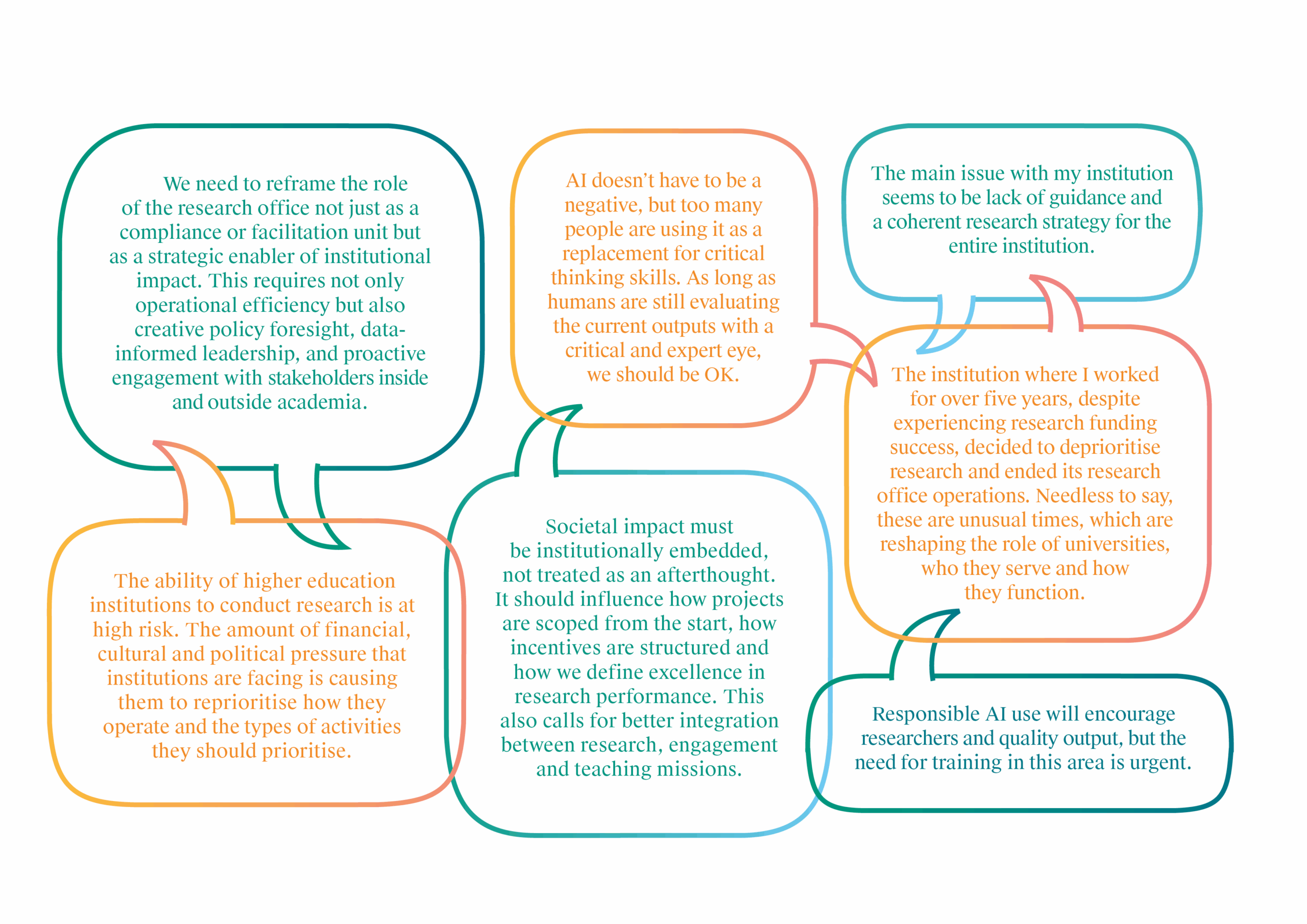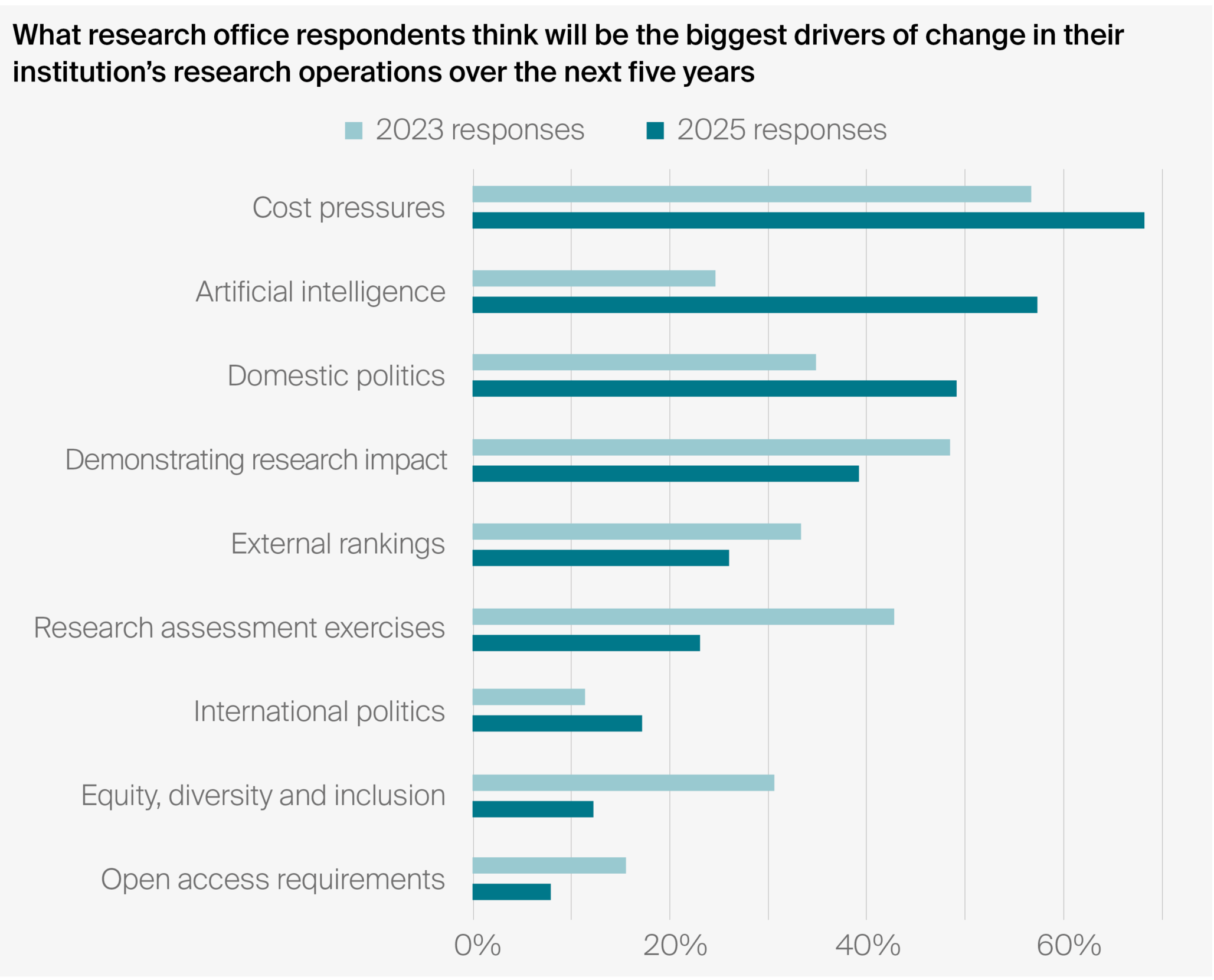
A new report from Research Professional News, an editorially independent part of Clarivate, explores the key priorities, challenges and drivers of change for academic research offices. Based on a global survey of more than 2,500 research office staff and researchers, the 2025 Research Offices of the Future report provides a comprehensive overview of the outlook for research offices and their relationships with researchers.
“The ability of higher education institutions to conduct research is at high risk,” said one of the survey respondents in the 2025 Research Offices of the Future report, published today by Research Professional News. “The amount of financial, cultural and political pressure that institutions are facing is causing them to reprioritise how they operate.”
Our report shows how research office staff and researchers are being affected by, and responding to, change — including the global effects of turbulence in U.S. research policy, artificial intelligence changing how people work and an increased focus on the societal impact of research.
As in 2023, when our previous Research Offices of the Future report was published, we carried out two surveys: one targeted at research office staff, the other at academics. More than 1,100 research office employees answered our call, with more than 1,400 academics doing the same. The results offer a striking snapshot of what they see as their biggest challenges and opportunities.

Caption: Respondents to our research offices survey told us about the main issues affecting their work.
In terms of institutional priorities for the next year, research office staff put the diversification of funding sources top, followed by enhancing research visibility and reputation, then obtaining more funding to increase the amount of research. It isn’t difficult to spot a trend here: two of the top three priorities relate strongly to funding strains.
In fact, when asked for their top challenges, both research office staff and researchers said budgets and resources, mentioned by 60% of the former and 58% of the latter.
Strained relationships
We also asked research office staff about the biggest challenges their institution faces in winning research funding. Engagement between researchers and the research office was the most frequently cited problem, selected by 57% of respondents. This was also the case in 2023, when 52% of respondents placed it in their top three challenges.
We also looked at views from the other side of the relationship. While overall levels of researcher satisfaction with the activities of their institution’s research office have remained fairly consistent since 2023, there has been a slight decline. This year, 34% of researchers described themselves as either very satisfied (6%) or satisfied (28%) with their research office, down from 38% in 2023.
Meanwhile, the overall proportion reporting negatively on satisfaction (either dissatisfied or very dissatisfied) is up from 30% two years ago to 37% this year.
AI surge
In the two years since our last survey, there has been no escaping the rise of artificial intelligence. The proportion of research office staff putting AI in their top three “change drivers” has jumped from just a quarter (25%) in 2023 to significantly more than half (57% in 2025).

Maybe this is no huge surprise given the acceleration of large language models, in particular, over the past two years. However, our survey also lifts the lid on how research office staff are already using AI in their work.
About a third of research office staff say they use AI tools for finding funding opportunities (selected by 35% of respondents), for editing or improving grant applications (33%) and for managing data (30%). Almost a quarter (24%) say they use AI to compile information for grant applications.
There were, however, notes of caution. When asked to give the top three factors they believe pose the biggest threats to research integrity, 60% of research office staff chose AI — more than any other option.
Societal benefit
Two years ago, research office staff told us that measuring and demonstrating societal impact was of rapidly increasing importance. Indeed, it came out top when we asked which types of impact staff believed would need to be measured most frequently in five years’ time.
However, the 2023 survey also found societal impact or benefit was perceived among respondents as the most difficult form of impact to measure — not an ideal juxtaposition.
Given this clear clash, the 2025 survey took a deeper dive into the issue of societal impact. Research office respondents told us why they consider it so important, citing public accountability, funding requirements and strategic differentiation as their top three factors.
We also wanted to know which outputs research office employees believe are of most importance when evaluating the societal impact of research. Academic publications ranked top overall (selected by 62%), followed by policy documents (42%), patents (39%) and non-academic publications such as magazine articles or blogs (28%).
We also asked research office staff and researchers to name the proxy measures that are most important when judging societal impact — and there were significant differences. While responses from research office staff produced a top three of media mentions (selected by 42%), citations from policy documents (41%) and recognition awards (36%), researchers went for readership stats (47%), mentions in teaching and learning materials (42%) and citations from research co-authored with non-academics (38%).
Discussions about precisely how societal benefit can be best measured are still very much ongoing, two years down the line from the last survey, it seems.
Full story
This blog reflects on just a few of the findings in the 2025 Research Offices of the Future report. We invite you to download the full report, which has further insights on areas such as the impact of U.S. politics on the global research scene, the biggest perceived threats to research integrity, and how research offices and academics interact day to day.
“We need to reframe the role of the research office not just as a compliance or facilitation unit but as a strategic enabler of institutional impact,” one respondent told us.
“This requires not only operational efficiency but also creative policy foresight, data-informed leadership, and proactive engagement with stakeholders inside and outside academia.”
We hope that the 2025 Research Offices of the Future report will help more people engage with these issues, as well as with the other challenges identified in the report.
Download and read the 2025 Research Offices of the Future report from Research Professional News.



